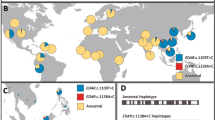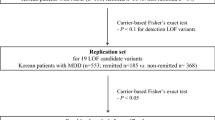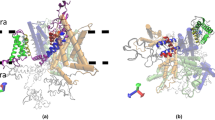ABSTRACT
Neurokinin receptors in the central nervous system are involved in the neural circuitry of anxiety, depression and emesis. This has led to the development of nonpeptidic NK1 receptor antagonists as therapeutic agents. Clinical trials have shown that NK1 receptor antagonists have efficacy in chemotherapy-induced emesis and depression. Sequence polymorphisms can potentially influence the efficacy of drugs in patient populations and are an important consideration in the drug development process. To identify DNA sequence variants in the NK1 receptor, comparative DNA sequencing was performed on a population of 93 individuals. In total, 19 single-nucleotide polymorphisms (SNPs) were identified with one SNP (g.78351T>C) resulting in a tyrosine to histidine subsitution at residue 192 (Y192H). The Y192H variant was expressed using site-directed mutagenesis and was characterized with respect to affinity, receptor kinetics, functional calcium response and receptor internalization. In all cases the Y192H variant was found to display properties similar to those of the wild-type receptor.
This is a preview of subscription content, access via your institution
Access options
Subscribe to this journal
Receive 6 print issues and online access
$259.00 per year
only $43.17 per issue
Buy this article
- Purchase on Springer Link
- Instant access to full article PDF
Prices may be subject to local taxes which are calculated during checkout




Similar content being viewed by others
References
Saria A . The tachykinin NK1 receptor in the brain: pharmacology and putative functions. Eur J Pharmacol 1999; 375: 51–60.
Duffy RA, Hedrick JA, Randolph G, Morgan CA, Cohen-Williams ME, Vassileva G et al. Centrally administered hemokinin-1 (HK1), a neurokinin NK1 receptor agonist, produces substance p-like behavioral effects in mice and gerbils. Neuropharmacology 2003; 45: 242–250.
Rupniak NMJ, Kramer MS . Discovery of the anti-depressant and anti-emetic efficacy of substance P receptor (NK1) antagonists. Trends Pharmacol Sci 1999; 20: 485–490.
Gardner CJ, Armour DR, Beattie DT, Gale JD, Hawcock AB, Kilpatrick GJ et al. GR205171: a novel antagonist with high affinity for the tachykinin NK1 receptor, and potent broad-spectrum anti-emetic activity. Regul Peptides 1996; 65: 45–53.
Kramer MS, Cutler N, Feighner J, Shrivastava R, Carman J, Sramek JJ et al. Distinct mechanism for antidepressant activity by blockade of central substance P receptors. Science 1998; 281: 1640–1645.
Gesztesi Z, Scuderi PE, White PF, Wright W, Wender RH, D'angelo R et al. Substance P (Neurokinin-1) antagonist prevents postoperative vomiting after abdonminal hysterectomy procedures. Anesthesiology 2000; 93: 931–937.
Navari RM, Reinhardt RR, Gralla RJ, Kris MG, Hesketh PJ, Khojasteh A et al. Reduction of cisplatin-induced emesis by a selective nurokinin-receptor antagonist. L-754,030 Antiemetic Trials Group. N Engl J Med 1999; 340: 1926–1928.
Poli-Bigelli S, Rodrigues-Pereira J, Carides AD, Julie Ma G, Eldridge K, Hipple A et al. Addition of the neurokinin 1 receptor antagonist aprepitant to standard antiemetic therapy improves control of chemotherapy-induced nausea and vomiting. Results from a randomized, double-blind, placebo-controlled trial in Latin America. Cancer 2003; 97: 3090–3098.
Roses AD . Genome-based pharmacogenetics and the pharmaceutical industry. Nat Rev Drug Discov 2002; 1: 541–549.
Steen VM, Lovlie R, Osher Y, Belmaker RH, Berle JO, Gulbrandsen AK . The polymorphic inositol polyphospahte 1-phosphatase gene as a candidate for pharmocogenetic predicition of lithium-responsive manic depressive illness. Pharmacogenetics 1998; 8: 259–268.
Green SA, Rathz DA, Schuster AJ, Liggett SB . The Ile164 beta(2)-adrenoceptor polymorphism alters salmerol exosite binding and conventional agonist coupling to G(s). Eur J Pharmacol 2001; 421: 141–147.
Arranz MJ, Munro J, Sham P, Kirov G, Murray RM, Collier DA et al. Meta-analysis of studies on genetic variation in 5-HT2A receptor and clozapine response. Schizophr Res 1998; 32: 93–99.
Güzey C, Spigset O . Genotyping of drug targets: a method to predict adverse drug reactions. Drug Saf 2002; 25: 553–560.
Fong TM, Yu H, Strader CD . Molecular basis for the species selectivity of the neurokinin-1 receptor antagonist CP-96345. J Biol Chem 1992; 267: 25668–25671.
Halushka MK, Fan J-B, Bentley K, Hsie L, Shen N, Weder A et al. Patterns of single-nucleotide polymorphisms in candidate genes for blood-pressure homeostasis. Nat Genet 1999; 22: 239–247.
Cargill M, Altshuler D, Ireland J, Sklar P, Ardlie K, Patil N et al. Characterization of single-nucleotide polymorphisms in coding regions of human genes. Nat Genet 1999; 22: 231–238.
Sachidanandam R, Weissman D, Schmidt SC, Kakol JM, Stein LD, Marth G et al. A map of human genome sequence variation containing 1.42 million single nucleotide polymorphisms. Nature 2001; 409: 928–933.
McLean S . Nonpeptide antagonists of the NK1 tachykinin receptor. Med Res Rev 1996; 16: 297–317.
Greenfeder S, Cheewatrakoolpong B, Anthes J, Billah M, Egan RW, Brown JE et al. Two related neurokinin-1 receptor antagonist have overlapping but different binding sites. Bioorg Med Chem 1998; 6: 189–194.
Greenfeder S, Cheewatrakoolpong B, Billah M, Egan RW, Keene E, Murgolo NJ et al. The neurokinin-1 and neurokinin-2 receptor binding sites of MDL103,392 differ. Bioorg Med Chem 1999; 7: 2867–2876.
McConalogue K, Dery O, Lovett M, Wong H, Walsh JH, Grady EF et al. Substance P-induced trafficking of β-arrestins: THE role of β-arrestins in endocytosis of the neurokinin-1 receptor. J Biol Chem 1999; 274: 16257–16268.
Tribut O, Lessard Y, Reymann JM, Allain H, Bentué-Ferrer D . Pharmacogenomics. Med Sci Monit 2002; 8: RA152–RA163.
Evans WE, Relling MV . Pharmacogenomics: translating functional genomics into rational therapeutics. Science 1999; 28: 487–491.
Sachse C, Brockmoller J, Bauer S, Roots I . Cytochrome P450 2D6 varients in a Caucasian population: allele frequencies and phenotypic consequences. Am J Hum Genet 1997; 60: 284–295.
Ingelman-Sundberg M, Oscarson M, Mclellan RA . Polymorphic human cytochrome P450 enzymes: an opportunity for individualized drug treatment. Trends Pharmacol Sci 1999; 20: 342–349.
Drazen JM, Yandava CN, Dube L, Szczerback N, Hippensteel R, Pillari Israel E et al. Pharmacogenetic association between ALOX5 promoter genotype and the response to anti-asthma treatment. Nat Genet 1999; 22: 168–170.
Baumgart D, Naber C, Haude M, Oldenburg O, Erbel R, Heusch G et al. G protein beta3 subunit 825T allele and enhanced coronary vasocontriction on alpha(2)-adrenoceotir activation. Circ Res 1999; 85: 965–969.
Smeraldi E, Zanardi R, Benedetti F, Di Bella D, Perez J, Catalano M . Polymorphism within the promoter of the serotonin transporter gene and antidepressant efficacy of fluvoxamine. Mol Psychiatry 1998; 3: 508–511.
Zanardi R, Benedetti F, Di Bella D, Catalano M, Smeraldi E . Efficacy of paroxetine in depression is influenced by a functional polymorphism within the promoter of the serotonin transporter gene. J Clin Psychopharmacol 2000; 20: 105–107.
Nickerson DA, Kolker N, Taylor SL, Rieder MJ . Sequence-based detection of single nucleotide polymorphisms. Methods Mol Biol 2001; 175: 29–35.
Nickerson DA, Tobe VO, Taylor SL . PolyPhred: automating the detection and genotyping of single nucleotide substitutions using fluorescence-based resequencing. Nucleic Acids Res 1997; 25: 2745–2751.
Antonarakis SE . Recommendations for a nomenclature system for human gene mutations. Hum Mutat 1998; 11: 1–3.
Cheng Y, Prusoff WH . Relationship between the inhibition constant (Ki) and the concentration of an inhibitor which causes 50 percent inhibition (IC50) of an enzymatic reaction. Biochem Pharmacol 1973; 22: 3099–3108.
Schild HO . Drug Antagonism and pAx. Pharmacol Rev 1957; 9: 242–246.
Author information
Authors and Affiliations
Corresponding author
Additional information
DUALITY OF INTEREST
None declared.
Rights and permissions
About this article
Cite this article
Randolph, G., Simon, J., Arreaza, M. et al. Identification of single-nucleotide polymorphisms of the human neurokinin 1 receptor gene and pharmacological characterization of a Y192H variant. Pharmacogenomics J 4, 394–402 (2004). https://doi.org/10.1038/sj.tpj.6500276
Received:
Revised:
Accepted:
Published:
Issue Date:
DOI: https://doi.org/10.1038/sj.tpj.6500276
Keywords
This article is cited by
-
Genotype frequencies for polymorphisms related to chemotherapy-induced nausea and vomiting in a Japanese population
Journal of Pharmaceutical Health Care and Sciences (2016)
-
Susceptibility Locus in Neurokinin-1 Receptor Gene Associated with Alcohol Dependence
Neuropsychopharmacology (2009)



